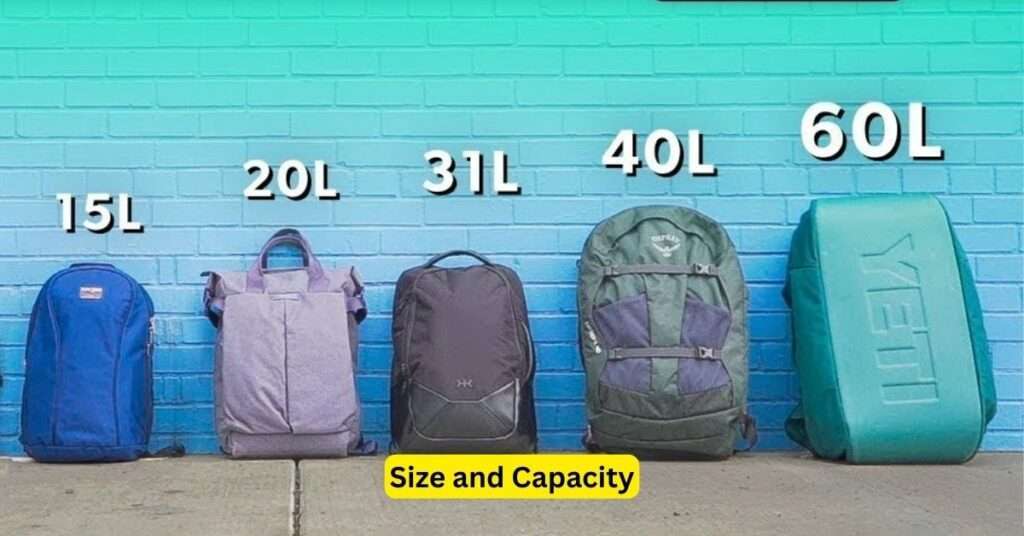
Choosing the right backpack is crucial for anyone who values comfort, convenience, and functionality, whether you’re an avid traveler, a student, a commuter, or an outdoor enthusiast. With countless options available on the market, selecting the perfect backpack can be overwhelming. However, with a clear understanding of your needs and the key features to consider, you can make an informed decision that meets your requirements.
In this comprehensive guide, we will delve into the essential factors to consider when choosing the right backpack. From size and capacity to materials and features, we’ll cover everything you need to know to ensure you find the perfect backpack for your needs.
Backpacks are not just functional; they are an extension of your style and personality. The right backpack not only serves its purpose but also complements your lifestyle and aesthetic preferences, whether you prefer sleek and modern designs or rugged and adventurous styles.
Size and Capacity

When it comes to backpacks, size matters. Choosing the appropriate size and capacity is crucial to ensure that your backpack can comfortably accommodate all your belongings without being too bulky or cumbersome. Here’s a breakdown of common backpack sizes and their ideal uses:
| Backpack Size | Ideal Use |
|---|---|
| Small | Day trips, commuting |
| Medium | Weekend getaways, school |
| Large | Extended travel, hiking, camping |
Before selecting a backpack size, consider how much gear you typically carry and the duration of your trips. If you frequently travel light, a small or medium-sized backpack may suffice, while longer trips or outdoor adventures may require a larger capacity.
When assessing capacity, pay attention to both liters and cubic inches to ensure compatibility with airline carry-on restrictions and storage limitations.
Determining the right size backpack involves considering not only the volume of items you’ll carry but also the dimensions of your body. A backpack that’s too large or too small can lead to discomfort and strain, so it’s essential to find the right balance.
Material and Durability

The durability of a backpack largely depends on the materials used in its construction. Opting for high-quality materials ensures longevity and reliability, even in challenging environments. Here are some common backpack materials to consider:
- Nylon: Lightweight and water-resistant, nylon is a popular choice for backpacks. Look for nylon fabrics with ripstop reinforcement for added durability.
- Polyester: Another durable and water-resistant option, polyester is commonly used in backpacks designed for everyday use.
- Canvas: Known for its sturdiness and classic aesthetic, canvas backpacks are durable but may be heavier than nylon or polyester alternatives.
- Leather: While less common for outdoor or travel backpacks, leather offers unmatched durability and a timeless appeal, making it ideal for business or fashion-forward backpacks.
The material choice not only affects the backpack‘s durability but also its weight and overall aesthetics. Consider your priorities and intended use when selecting the right material for your backpack.
Comfort and Fit

A comfortable backpack can make all the difference, especially during long hours of wear. Proper fit and ergonomic design are essential for minimizing strain and discomfort. Here are some key features to look for:
- Adjustable Straps: Opt for backpacks with padded, adjustable shoulder straps to distribute weight evenly and prevent shoulder fatigue.
- Padded Back Panel: A padded back panel provides cushioning and airflow to prevent discomfort and sweat buildup.
- Hip Belt: For larger backpacks or heavy loads, a hip belt helps transfer weight from your shoulders to your hips, reducing strain on your back.
- Load-Lifting Straps: These adjustable straps help stabilize the backpack and pull the weight closer to your body, improving balance and comfort.
Features and Organization
The right backpack should not only accommodate your belongings but also keep them organized and easily accessible. Consider the following features for optimal organization:
- Compartments and Pockets: Look for backpacks with multiple compartments and pockets to separate and store items efficiently.
- Laptop Sleeve: If you carry a laptop or tablet, choose a backpack with a padded laptop sleeve or compartment for added protection.
- Water Bottle Pockets: Stay hydrated on the go with external water bottle pockets that keep your drink easily accessible.
- Compression Straps: Compression straps allow you to adjust the volume of your backpack and keep contents secure, minimizing shifting during travel.
- External Attachment Points: D-rings, loops, and gear attachment points provide versatility for attaching additional gear or accessories.
Evaluate your storage needs and preferences to determine which features are essential for your daily activities or travel adventures.
Organization features play a significant role in ensuring easy access to your belongings and maximizing space efficiency. Choose a backpack with a layout that suits your packing style and preferences.
Conclusion & Recap
In conclusion, choosing the right backpack requires careful consideration of several key factors, including size, capacity, materials, comfort, and features. By assessing your needs, preferences, and intended use, you can narrow down your options and find the perfect backpack that meets your requirements.
Here’s a recap of the essential points covered in this guide:
- Size and Capacity: Determine the appropriate size and capacity based on the duration of your trips and the amount of gear you typically carry. Consider factors such as liters and cubic inches to ensure compatibility with your needs.
- Material and Durability: Choose high-quality materials such as nylon, polyester, canvas, or leather based on your priorities for durability, weight, and aesthetics. Pay attention to features like denier and water resistance for added durability.
- Comfort and Fit: Look for backpacks with adjustable straps, padded back panels, hip belts, and load-lifting straps to ensure a comfortable fit and proper weight distribution. Test the backpack with weight to assess comfort before purchasing.
- Features and Organization: Evaluate storage needs and preferences to determine essential features such as compartments, laptop sleeves, water bottle pockets, compression straps, and external attachment points. Choose a layout that suits your packing style and maximizes space efficiency.
- Style and Aesthetics: Consider the overall design and aesthetic of the backpack to ensure it complements your personal style and preferences. Whether you prefer sleek and modern designs or rugged and adventurous styles, find a backpack that reflects your personality.
- Budget: Set a budget based on your financial constraints and prioritize features accordingly. While high-quality backpacks may come with a higher price tag, they often offer better durability and performance in the long run.
By following these guidelines and considering your individual needs and preferences, you can confidently choose the right backpack for your lifestyle and activities. Remember to prioritize comfort, functionality, and durability to ensure a rewarding backpacking experience.
Now that you’re equipped with the knowledge to make an informed decision, go ahead and explore the wide range of backpack options available, keeping in mind the factors discussed in this guide. Whether you’re embarking on a new adventure or simply commuting to work, your backpack will be your trusted companion every step of the way. Choose wisely and enjoy the journey!
Frequently Asked Questions (FAQs)
What size backpack should I choose for traveling?
The size of the backpack depends on the duration of your trip and the amount of gear you need to carry. For short trips or daily commuting, a small to medium-sized backpack is suitable. For longer trips or outdoor adventures, opt for a larger backpack with ample capacity.
Are there specific backpacks for hiking or camping?
Yes, there are backpacks designed specifically for hiking and camping, featuring durable materials, ample storage space, and specialized compartments for outdoor gear such as sleeping bags, tents, and hiking poles. Look for backpacks with features like hydration reservoir compatibility, external attachment points, and adjustable suspension systems for added comfort and functionality.
How do I ensure my backpack is comfortable to wear?
To ensure comfort, choose a backpack with adjustable straps, padded back panels, hip belts, and load-lifting straps. Adjust the straps to distribute weight evenly across your shoulders and hips, and test the backpack with weight before purchasing to assess comfort.
What materials are best for backpack durability?
High-quality materials such as nylon, polyester, canvas, and leather are commonly used for backpack construction. Look for materials with reinforced stitching, water-resistant coatings, and high denier ratings for added durability and longevity.
Can I use a backpack as a carry-on for flights?
Yes, many backpacks are designed to meet airline carry-on size restrictions. However, it’s essential to check the dimensions and weight limits specified by the airline before traveling to ensure your backpack complies with their policies.
How do I clean and maintain my backpack?
To clean your backpack, use a mild detergent and lukewarm water to spot clean stains. Avoid using harsh chemicals or bleach, as they can damage the fabric. Allow your backpack to air dry thoroughly before storing it. Regular maintenance, such as inspecting seams and zippers for damage, can help prolong the lifespan of your backpack.
Are there backpacks suitable for carrying laptops or tablets?
Yes, many backpacks come with padded laptop sleeves or compartments designed to protect electronic devices. Look for backpacks with dedicated laptop compartments and padded sleeves to ensure your devices stay safe and secure during transport.
What features should I look for in a backpack for everyday use?
For everyday use, consider features such as multiple compartments and pockets for organization, padded shoulder straps for comfort, and a durable yet lightweight construction. Additionally, look for features like water bottle pockets, key clips, and internal organization panels to keep your essentials easily accessible.

